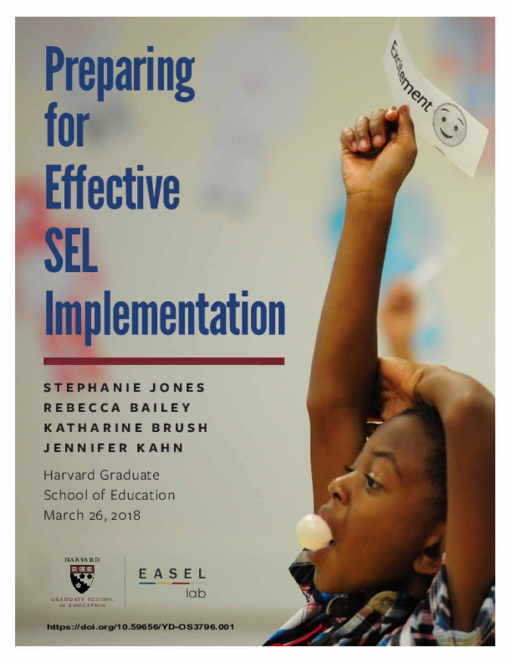Breadcrumb
- Wallace
- Reports
- Preparing For Effective Sel Impl...
Preparing for Effective SEL Implementation

- Author(s)
- Stephanie Jones, Rebecca Bailey, Katharine Brush, and Jennifer Kahn
- Publisher(s)
- Harvard Graduate School of Education
Summary
How we did this
For a detailed description of the overall study methodology, including the program selection criteria and coding/data collection system, please see Appendices B and C of the full report, Navigating SEL from the Inside Out: Looking Inside and Across 33 Leading SEL Programs.
Academic achievement and physical and emotional well-being are two of many positive outcomes associated with school-based SEL. These outcomes are both short and long-term.
But program implementation matters. Inconsistent or ineffective SEL implementation can produce less powerful results. And disorganized approaches can do more harm than good, affecting both staff morale and student engagement in a negative way.
This brief summarizes the features and best practices of effective social and emotional learning (SEL) programs. It offers recommendations for effective SEL implementation. It also offers guidance to help practitioners make informed decisions about SEL program selection.
Effective SEL implementation requires careful planning. It also requires the selection of programs or strategies that meet the needs of a particular context.
Common Features of Effective SEL Programs
The most effective SEL programs incorporate four elements represented by the acronym SAFE:
- Sequenced activities that lead in a coordinated and connected way to skill development
- Active forms of learning that enable children to practice and master new skills
- Focused time spent developing one or more social and emotional skills
- Explicit defining and targeting of specific skills
Building upon these SAFE elements, SEL programs are most effective when they also:
- Occur within supportive contexts.
- Build adult competencies
- Partner with family and community
- Target key behaviors and skills
- Set reasonable goals
Recommendations for Effective Implementation
A strong, evidence-based SEL curriculum must be well-implemented to deliver positive outcomes. The authors outline a set of recommendations for effective SEL implementation.
- Allot program implementation time sufficiently and effectively
- Extend SEL beyond the classroom
- Apply SEL strategies and skills in real time
- Ensure enough staff support and training
- Facilitate program ownership and buy-in
- Use data to inform decision-making
Program Selection Process
The authors conclude the brief by offering a process for making informed program selection decisions.
- Use data to guide decision making
- Include key stakeholders
- Identify needs and goals
- Select a program using selection tools/resources
This guidance includes links to tools and worksheets to help guide the program selection process.

One large-scale review of prevention programs found that in more than 500 studies, implementation practices had an important impact on program outcomes.
Key Takeaways
- Academic achievement and physical and emotional well-being are two of many positive outcomes associated with SEL programs.
- Positive SEL program outcomes depend on high quality program implementation. Inconsistent or ineffective implementation can produce less powerful results. Disorganized approaches can yield negative results.
- Effective program implementation requires careful planning. It also requires selection of programs or strategies that meet the needs of a particular context.
- The most effective SEL programs include four elements: Sequenced activities, active forms of learning, focused time, and explicit defining and targeting of skills.



